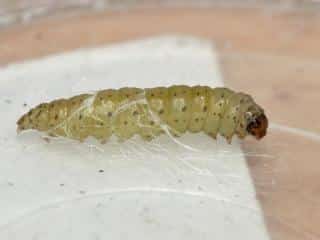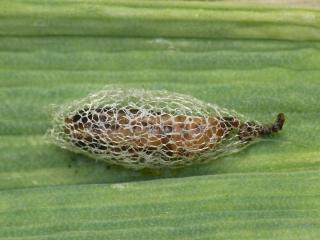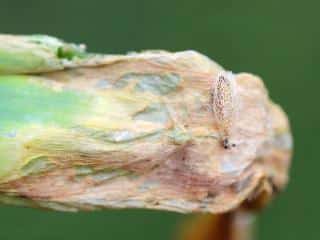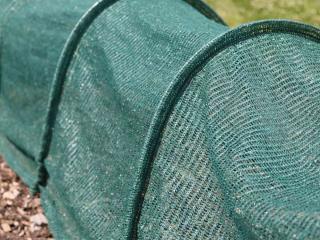

Leek is fairly susceptible to pest attacks. The leek moth is clearly one of its main enemies! Here’s how to identify Acrolepiopsis assectella and fight it better. This bugger is often confused with both the leek leaf miner and the onion fly.
Acrolepiopsis assectella is a night butterfly with a wingspan of approximately 5/8 to 7/10 inch (16 to 18 mm). This Lepidoptera has an easily identifiable brown body. Its wings, very elongated, are also grayish brown and dotted with black. Two white spots stand out on the forewings while the hindwings are grayer.
 The caterpillar, approximately 1/2 inch long (13 mm), is a yellowish-white or greenish color. Its body is sprinkled with black dots and light bands, the head has a dark tan hue. A few hairs cover its body. Leek moth attacks all alliums, namely leek, but also garlic, onion, shallot and chive, and even daylily in ornamental beds. That’s why it can be confused with the leek leaf miner (Phytomyza gymnostoma) , and with the onion fly (Delia antiqua), two diptera that cause more or less the same damage.
The caterpillar, approximately 1/2 inch long (13 mm), is a yellowish-white or greenish color. Its body is sprinkled with black dots and light bands, the head has a dark tan hue. A few hairs cover its body. Leek moth attacks all alliums, namely leek, but also garlic, onion, shallot and chive, and even daylily in ornamental beds. That’s why it can be confused with the leek leaf miner (Phytomyza gymnostoma) , and with the onion fly (Delia antiqua), two diptera that cause more or less the same damage.
→ For further reading: Leek leaf miner, control and treatment and Onion fly, prevention and treatments
The leek moth usually spends winter well protected beneath heaps of dead leaves, among twigs or in bark crevices. Sometimes it even lays dormant as a pupa in unharvested leek.
The first flight of the leek moth occurs in April-May, as soon as nighttime temperatures approach 54 °F (12 °C). After mating, the female (who lives just over a month) lays hundreds of eggs which she deposits on leek leaves in the evening.
Ten days later, larvae hatch. It is at this stage that damage is most significant. They first attack the upper part of the leaf they hatched on, which quickly turns yellow. Then, the caterpillar burrows deeper into the leek stem which it gnaws at from the inside.
 Satiated, it pupates into a spindle-shaped, see-through cocoon-like web, placed on the leaves. From these cocoons, a new generation of butterfly arises.
Satiated, it pupates into a spindle-shaped, see-through cocoon-like web, placed on the leaves. From these cocoons, a new generation of butterfly arises.
Ultimately, three generations can follow one another within the year. You can clearly track the three waves of adults fluttering around:
Then, in October, when temperatures drop, larvae and moths hibernate either in the adult state or in the pupal state. It is especially the last two generations that cause the most damage.
 Often, the first sign of a leek moth attack is when holes and galleries appear on the underside of leaves. Foliage is covered with fuzzy white spots, and wilts.
Often, the first sign of a leek moth attack is when holes and galleries appear on the underside of leaves. Foliage is covered with fuzzy white spots, and wilts.
Then, very quickly, caterpillars reach the leek stem which they start devouring. Since it gets wet because of sap and water, it starts rotting from the inside, sometimes causing the death of the plant.
In any case, crop development is considerably slowed down. Furthermore, the leek becomes inedible.
As often, prevention and good practices can limit and even prevent infestations.
 Place an insect net as early as May. This is probably the most effective protection as it prevents egg-laying. Choose a very fine mesh net and place it on arches ensuring there are no gaps. Keep this net on leek plots until October. It also protects against leek leaf miner.
Place an insect net as early as May. This is probably the most effective protection as it prevents egg-laying. Choose a very fine mesh net and place it on arches ensuring there are no gaps. Keep this net on leek plots until October. It also protects against leek leaf miner. Grow carrot in between leek rows to keep moths away. In reverse, leek also keeps the carrot fly away. You can also grow plants that emit strong smells around your plots of leek. They confuse the moth, which can no longer find the leeks. Examples are fennel, celery, lavender, wild thyme…
Grow carrot in between leek rows to keep moths away. In reverse, leek also keeps the carrot fly away. You can also grow plants that emit strong smells around your plots of leek. They confuse the moth, which can no longer find the leeks. Examples are fennel, celery, lavender, wild thyme…If the infestation is real and caterpillars have settled settled, it’s not too late to fight the intruder off! But you must act before caterpillars penetrate to the heart of the leek:
Otherwise, if caterpillars have reached the stem, your only option left is to cut the leek short. Upper leaves should grow back as long as the caterpillar hasn’t burrowed too deep.
→ To go further: